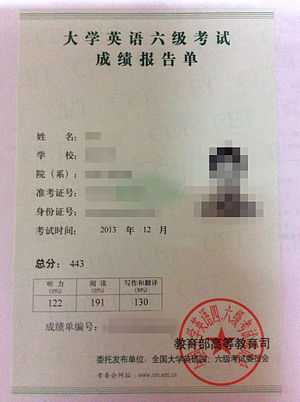College English Test

The College English Test (simplified Chinese: 大学英语考试; traditional Chinese: 大學英語考試; pinyin: Dàxué Yīngyǔ Kǎoshì), better known as CET, is a national English as a foreign language test in the People's Republic of China. The purpose of the CET is to examine the English proficiency of undergraduate students and postgraduate students in China and ensure that Chinese undergraduates and postgraduates reach the required English levels specified in the National College English Teaching Syllabuses (NCETS).[1] This test has existed in China for 26 years and now has a huge test population of 18 million people annually.
Before 2005 reform
Before the 2005 reform, the maximum score was 100 points. This test was held nationally twice a year in June and December. The CET consisted of the non-English-specialized "Band 4" (CET4), in which certificate-holders have reached the English level of non-English major undergraduate students, and "Band 6" (CET6), in which the certificate-holders have reached the English level of non-English major postgraduates. The test included listening, reading and writing sections. The spoken test was optional and required certain points from the written test.
2005 reform
The CET was reformed in 2005. Several changes were made, including:
- Re-ordered and re-organized sections; more listening and spoken sections; new "Skimming & Scanning" and "Translation" sections;
- New grading system: scores are graded on a curved scale, so that the highest score possible is 710, while the lowest mark is a score of 290(finish all questions but all wrong);
- Passing grades and qualification certificate elimination;
- A more detailed score report on each section;
- Public service elimination: only university students need to take the test.
The CET is mandatory for university students in China who are not English majors. It is also a prerequisite for a bachelor's degree. Many employers in China prefer applicants with CET certification.
Passing the CET is important for Chinese college students. Graduates may only be able to get a degree or a good job if they can pass the CET with a high score.
While the CET tests reading, writing and listening, it does have a separate test for speaking. The speaking test is held twice a year and only students with a CET Band-4 score higher than 550 or a CET Band-6 higher than 520 are eligible for the test.
Test for English Majors
A similar but more rigorous test, the Test for English Majors (TEM), is mandatory for English majors. For these students, passing the TEM-4 is a graduation requirement. The test should be taken by the end of the second academic or sophomore year. TEM-8 ("Band 8") is the highest level for English major students; it should be taken during the end of the last academic or senior year.
If an English-major student fails to pass the TEM-4 during his or her sophomore year, they may attempt to pass the TEM-8 during their senior year. Those failing the TEM-8 are only allowed one re-test (during the following year after they have graduated from college). A second failure results in disqualification.[2]
Vocabulary Requirements
- CET-4: 4000 words
- CET-6: 6000 words
- TEM-4: 8000 words
- TEM-8: 13000 words
Social consequences
Some Chinese researchers point out the positive social consequences of the CET as it has promoted the role of English teaching and learning at the tertiary level in China over its 20-year history.[3][4] At the same time, other researchers[5] challenge the CET by pointing out that the test does not assess communicative competence as the teaching syllabus requires. Before the recent reform of the CET, the large proportion of multiple choice questions made this test an efficient one, but possible sacrifices in accurately measuring English language ability remained a concern.[6] Since the CET certificates had been one of the graduation requirements of undergraduates in the majority of Chinese universities for almost 20 years, test-oriented teaching was another severe problem. However, there have been changes made in the CET test content, format, and scoring systems are evidence of the endeavors to bring about positive washback of the test on English teaching and learning in China. It is the expectation of the CET committee that the test can reflect and catch up with the needs of rapid economic reform and the new open-door policy.[7]
See also
- National College Entrance Examination
- English education in China
- Education in the People's Republic of China
- Teaching English as a foreign language
- Public English Test System
References
- ↑ Syllabus for College English Test. Shanghai, China: Shanghai Language Education Press. 2006.
- ↑ accurapid.com
- ↑ Gu, X (2005). Positive or negative? An empirical study of CET washback on college English teaching and learning in China.
- ↑ Li, J (2002). "The current College English Test in China: Problems and thoughts". Language Education 23: 33–38.
- ↑ Han,Yang, Dai, L (2004). "Problems with College English Test as". Foreign Languages and Their Teaching 179: 17–23.
- ↑ Zhang, X (2003). "On the negative impact of College English Test Band 4". Educational Science 19: 35–39.
- ↑ Jin, Y (2006). "On the improvement of test validity and test washback: The CET". Foreign Language World 6: 65–73.
| ||||||||||||||||||||||||||||||||||||||||||||||||||||||